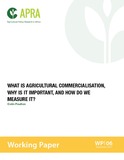| dc.contributor.author | Poulton, Colin | |
| dc.date.accessioned | 2018-02-19T13:14:29Z | |
| dc.date.available | 2018-02-19T13:14:29Z | |
| dc.date.issued | 2017-11-01 | |
| dc.identifier.citation | Poulton, Colin. (2017) ‘What is Agricultural Commercialisation, Why is it Important, and how do we Measure it?’ APRA Working Paper 6, Future Agricultures Consortium | en |
| dc.identifier.isbn | 978-1-78118-425-7 | |
| dc.identifier.uri | https://opendocs.ids.ac.uk/opendocs/handle/20.500.12413/13560 | |
| dc.description.abstract | Agricultural commercialisation occurs when agricultural enterprises and/or the agricultural sector as a whole rely increasingly on the market for the sale of produce and for the acquisition of production inputs, including labour. It is an integral and critical part of the process of structural transformation (see section 1.1), through which a growing economy transitions, over a period of several decades or more: from one where the majority of the population live in rural areas and depend directly or indirectly on semi-subsistence agriculture for an important part of their livelihood to one where the majority of the population live in urban areas and depend on employment in manufacturing or service industries for the major part of their livelihood. As such, agricultural commercialisation is an endogenous process that interacts with developments
in others sectors of the economy and whose impacts depend critically on conditions in those other sectors. It proceeds via the decisions of numerous private agents – farmers, input suppliers, traders and processors. However, these can also be influenced by purposive investments by public and social actors (states, donors, non-governmental organisations (NGOs), foundations). For analytical purposes, these investments can be considered as exogenous initiatives to promote
commercialisation In this paper we draw on existing literature to consider these different types of agricultural commercialisation. For each, we consider the conditions in other sectorsof the economy and polity that stimulate agricultural commercialisation and mediate its impacts, as well as public policy actions that might encourage commercialisation, its potential benefits, and the likely configuration of winners and losers. We observe that both the dynamics and the impacts of agricultural commercialisation differ according to whether the commercialisation in question occurs early or late within the process of structural transformation or, more specifically, before or after the so-called ‘Lewis
turning point’ (see section 1.1). We also observe that the impacts depend on whether the commercialisation in question occurs in areas of low or high population density. The final section of the report discusses the measurement of agricultural commercialisation in the light of this review. The paper begins, however, with a brief discussion of the process of structural transformation within an economy, followed by consideration of semi-subsistence farm households, as these are the starting point from which agricultural commercialisation proceeds. | en |
| dc.language.iso | en | en |
| dc.publisher | APRA, Future Agricultures Consortium | en |
| dc.relation.ispartofseries | APRA Working Papers;6 | |
| dc.rights.uri | http://creativecommons.org/licenses/by-nc-nd/3.0/ | en |
| dc.subject | Agriculture | en |
| dc.subject | Development Policy | en |
| dc.subject | Economic Development | en |
| dc.subject | Gender | en |
| dc.subject | Nutrition | en |
| dc.subject | Rural Development | en |
| dc.title | What is Agricultural Commercialisation, Why is it Important, and how do we Measure it? | en |
| dc.title.alternative | APRA Working Paper 6 | en |
| dc.type | Series paper (non-IDS) | en |
| dc.rights.holder | APRA, Future Agricultures Consortium | en |
| dc.identifier.team | Rural Futures | en |
| dcterms.dateAccepted | 2017-11-01 | |
| rioxxterms.funder | Department for International Development, UK Government | en |
| rioxxterms.identifier.project | APRA | en |
| rioxxterms.version | NA | en |
| rioxxterms.funder.project | e1f6d3be-457a-4f13-8b1f-6748d1402d83 | en |


